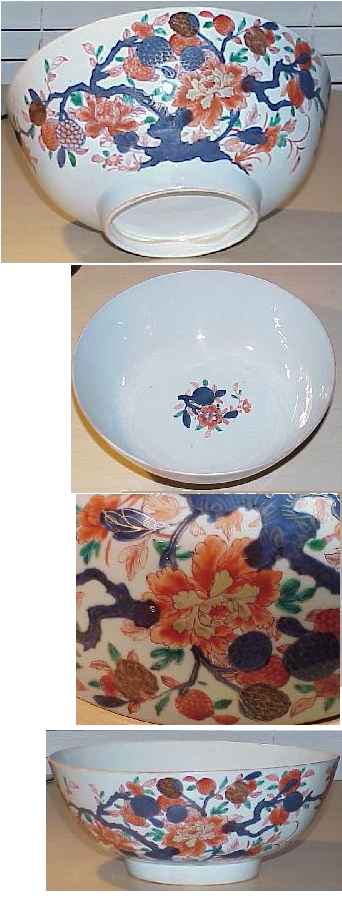
This page is only one of many thousands of Gotheborg.com Help and Information Pages, offering specialized knowledge on Chinese and Japanese Porcelain, including a Glossary, Q&A, Chinese and Japanese Porcelain Marks, Chinese Porcelain Exhibition and Excavation reports etc. For personal help and far more information, join our Discussion Board or use 'Ask a Question' for quick email consultations. For full text and better navigation, use a full-screen device rather than a mobile phone, that offers only limited content.
 Here are a few pictures of a footed bowl, 26.3cm in diameter and 11.5cm high, it is underglaze blue with the colors of red, green and gold. It is beautifully simple in its decoration of flowers and berry's, it's thin porcelain with a glaze of a grayish/blue color under a halogen light, and grayish/green under an OTT-lite which is a natural color fluorescent light, used by many in the jewelry business. I would like to know if you could help me with some information on this?
Here are a few pictures of a footed bowl, 26.3cm in diameter and 11.5cm high, it is underglaze blue with the colors of red, green and gold. It is beautifully simple in its decoration of flowers and berry's, it's thin porcelain with a glaze of a grayish/blue color under a halogen light, and grayish/green under an OTT-lite which is a natural color fluorescent light, used by many in the jewelry business. I would like to know if you could help me with some information on this?
This is an early Chinese export porcelain punch bowl from the early years of the 18th century, but not as early as the Kangxi period (1662-1722). Green enamels from the 'Famille Verte' palette occur alongside with the traditional 'Imari' decoration in iron red, gold and underglaze blue. The decoration is thus a descendant of the Ming dynasty's 'Wanli wucai,' or 'five-color enamels, and did occur during the Kangxi period.
However, as we can see, some small flowers are decorated with pink enamels that signify 'famille rose,' which was not invented or at least popularized before the Qianlong period (1736-1795). Which is why I believe this bowl belongs to the second quarter of the 18th century.
The most likely markets for this bowl would have been England or Sweden. Sweden began trading with China in 1731, and England started earlier, while the Dutch preferred blue and white. The quality and the high price this bowl must have commanded would have made it interesting only for the British 'private trade,' where it was widely recognized that every ounce of cargo mattered and the higher the quality, the higher the profit when eventually back home in England.
Another point is that the "pounch" was invented on board the East Indiamen as a cure to scurvy. The sailors thought the officers intended to trick them out of their nice beer, when they were offered "lemon juice" instead; and flatly refused to drink it if it was not mixed with the two ingredients their tedious and salty diet made them want most of all - sugar and alcohol.
The alcohol that was least expensive for the company to buy was "arrack" a local concoction from Java which is until today is used for making of Pounche, or as it is called in Sweden, "Punch".
In Java and other parts of Indonesia, arrack is still traditionally made from the fermented sap of coconut flowers or sugarcane, sometimes with the addition of red rice. It is distilled to produce a strong spirit that has been a part of local cultures for centuries. The Indonesian version is sometimes called "arak" or "batavia arrack," the latter named after the colonial name of Jakarta.
Jan-Erik Nilsson